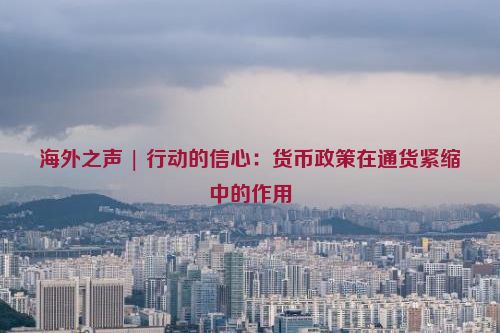导读
欧元区当前正面临着一系列由需求和供应冲击引发的高通胀挑战,而其对进口能源的依赖更是加剧了这一复杂局面。这些冲击犹如对收入的外部征税,最初由工人们通过降低实际工资来默默承受。然而,近期这些冲击的逆转以及紧缩性货币政策的实施,已经开始逐渐减缓通胀的步伐。尽管就业率有所提升,但工人的实际工资仍未能恢复到疫情前的水平。本文着重指出,欧元区因遭遇前所未有的冲击,特别是能源行业以及俄乌冲突后的影响,通胀水平达到了创纪录的高点。为了应对这一严峻形势,欧洲央行果断地提高了政策利率,并积极推进欧元系统资产负债表的正常化,从而实现了通胀的广泛回落。

然而,要实现经济的强劲复苏,实际工资的增长是不可或缺的。本文强调,欧盟不应过分拘泥于短期的工资变化,而忽视工资复苏的必要性。虽然为了维持通胀率向欧洲央行设定的2%目标靠近,工资增长需要得到一定的控制,但我们也必须采取一种平衡的方法,以免扼杀经济的复苏势头。欧洲央行在此方面保持谨慎态度,它在调整政策利率前会静待更多的数据,以确保对不断变化的经济状况做出恰如其分的反应。在考虑到经济长期停滞的风险以及复苏速度可能超预期的情况下,欧洲必须采取适度的货币政策。展望未来,欧洲央行正密切注视着工资动态以及其他经济指标的变化。最近的数据显示,工资增长正在逐步放缓,与生产率的增长保持同步,这进一步印证了欧洲央行关于通胀率逐步接近目标利率的预测。
最后,文章重申了欧洲央行致力于确保货币政策继续为经济复苏提供有力支持,同时确保通胀率稳步向目标靠近的坚定立场,并强调了短期内工资的反弹是实现经济复苏和生产率增长的关键条件,而这最终将带来一个稳定的经济环境,使通胀得到有效控制。
作者丨Piero Cipollone(欧洲中央银行执行董事会成员)
The confidence to act: monetary policy and the role of wages during the disinflation process
Speech by Piero Cipollone, Member of the Executive Board of the ECB,
at an event organized by the House of the Euro and the Centre for European Reform
Brussels, 27 March 2024
It is a pleasure to be here today.
In recent years, the euro area economy has experienced a series of overlapping demand and supply shocks, which resulted in persistently high inflation.
Due to its dependence on imports hit by those shocks, the euro area also suffered a negative terms-of-trade shock. This acted as an external tax on euro area income that, in practice, was initially absorbed mostly by workers in the form of lower real wages.
The reversal of these negative supply shocks, combined with our restrictive monetary policy, has led to a broad-based decline in inflation, while inflation expectations remain well anchored. This, in turn, has shifted the discussion towards the timing, pace and extent of the reduction in monetary policy restriction going forward.
Our decisions continue to be informed by the inflation outlook and the risks surrounding it. One important aspect relates to the risk that wage and productivity growth might be inconsistent with the convergence of inflation to our medium-term target of 2%.
Certainly, in a steady-state scenario, keeping wage rises in line with productivity growth and the inflation target is necessary. It prevents unsustainable cost pressures, which firms would have to pass on to customers, resulting in above-target inflation.
But we are not in a steady-state scenario yet. Real wages are still below their pre-pandemic level – even more so than productivity – while unit profit growth has until recently been high relative to the historical average. Today, the share of labour in value added remains lower than before the COVID-19 shock, despite the level of employment increasing by 3.8% in the same period.
Profits are now normalizing, while the ongoing reversal of negative supply shocks creates additional room for a catch-up in real wages that will contribute to the economic recovery consistent with our staff projections and with a convergence to our inflation target.
Indeed, in the projections, this catch-up is a condition for the increase in private consumption. But even at the end of the projection horizon, real wages are still expected to be slightly below the level that would be justified by labour productivity growth since the pandemic.
Just as real wage growth cannot be sustained over time if it continuously overshoots productivity growth, output and productivity growth are unlikely to be sustained over time if wages and domestic demand remain permanently depressed. This may lead to a protracted underestimation of resources, with potential output eventually adjusting downwards to meet depressed demand.
Let me be clear: wage growth needs to moderate over the medium term for a sustained convergence of inflation to our target. But an excessive focus on short-term wage developments may not take into full consideration the recovery in wages that can – and needs to – take place for the euro area’s currently.
fragile recovery to gain a stronger footing. If the economy does not recover, this would mechanically put downward pressure on productivity growth or on employment.
Today, the process of disinflation is surrounded by less uncertainty as supply shocks reverse and risks to the inflation outlook have balanced out. We are increasingly confident that inflation will converge to 2% by mid-2025.
Waiting for further data before starting the normalization of our policy rates, gives us additional insurance against upside risks to inflation. But we should remain proportionate going forward given an economy that has stagnated for 18 months, risks to the economic outlook that are skewed to the downside, and credit conditions that are in restrictive territory.
If incoming data confirm the scenario foreseen in the March projections, we should stand ready to swiftly dial back our restrictive monetary policy stance. Increased confidence in a timely return of inflation to our target should then allow forward-looking information to regain prominence in our reaction function.
The rise and fall of inflation in the euro area
The inflation surge
Headline inflation in the euro area increased to record levels following a string of unprecedented and intersecting demand and supply shocks, with the latter playing the primary role (Chart 1).
Chart 1
Dynamic decomposition of euro area headline inflation using the Bernanke-Blanchard model (year-on-year growth rate and percentage point contributions)
In particular, energy inflation, already at elevated levels, soared to above 40% year on year in the wake of Russia’s invasion of Ukraine. Headline inflation became increasingly broad-based as high energy costs spread throughout the economy, driving food and services prices higher - albeit with lagged effects (Chart 2).
Chart 2
Contribution of components to euro area headline inflation (annual percentage changes and percentage point contributions)
Given Europe’s reliance on energy imports, soaring energy prices also constituted a negative terms-of-trade shock for the euro area (Chart 3), which acted as an external tax on income that had to be collectively absorbed by labour and capital. In practice, however, it was real wages that initially absorbed most of this tax. They declined markedly in 2022 and remained below their pre-pandemic level at the end of last year (Chart 4).
Chart 3
Euro area terms of trade and energy import prices
(left-hand scale: terms-of-trade ratio, right-hand scale: energy import prices)
Chart 4
Real compensation per employee in the euro area (index: Q4 2019 = 100)
Supported by a tight labour market in the euro area, workers have sought higher nominal wage growth, initially to reduce real income losses and subsequently to recoup them. But wage growth remained slightly below inflation in 2023 and is only expected to exceed it in 2024.






